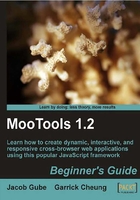
Chapter 1. MooTools and Me
In recent years, the Web has undergone a major evolution, an evolution towards highly-interactive, dynamic, responsive web pages and web applications. We're at a time where users expect (and often, demand) web interfaces that talk to them.
Gone are the days where only desktop software was associated with smooth and feature-packed user interfaces that performed complicated tasks. In fact, applications that we normally think of as traditionally being for the desktop (such as Word Processors, Image editors, and Spreadsheet software) are now moving to browser-based environments because of the many advantages of web-based applications (such as operating system/platform interdependency, interoperability with other systems, and collaborative possibilities).
JavaScript is the technology that's driving this evolution by giving web developers the capability to create complex, robust, interactive web page components and Rich Internet Applications (RIA) that respond effortlessly to user actions through a combination of techniques such as Ajax, on-the-fly DOM manipulation, and smooth, animated effects.
However, JavaScript isn't perfect (in fact, it's far from it), its syntax is sometimes unintuitive and repetitive, and often requires a great deal of code-authoring to perform complicated and cross-browser-compatible operations.
This is where MooTools steps in! By providing web developers with a set of useful and cross-browser-compatible functions, methods, and classes within an intuitive framework for writing client-side scripts, we can side-step a lot of frustration and time, typically associated with code-authoring in JavaScript:
In this chapter we shall:
- Learn about what MooTools is
- Discuss some advantages of using MooTools
- Learn how to download and install MooTools
- Learn about notable MooTools resources on the web
So let's get on with it!